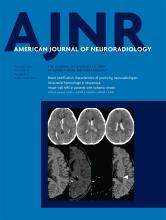Abstract
BACKGROUND AND PURPOSE: Alzheimer disease is the most common degenerative dementia affecting humans and mild cognitive impairment is considered the forerunner of this devastating illness with variable progression. Differentiating between them has become all the more essential with the advent of disease-modifying medications. The aim of this study was to test the utility of the entorhinal cortical atrophy score in combination with quantitative CBF in the posterior cingulate and precuneus using arterial spin-labeling to differentiate mild cognitive impairment and early Alzheimer disease.
MATERIALS AND METHODS: We analyzed MR imaging from a prospective data base of 3 age-matched groups: 21 cognitively healthy controls, 20 patients with mild cognitive impairment, and 19 patients with early Alzheimer disease. The highest entorhinal cortical atrophy score and an atlas-based measurement of CBF in the posterior cingulate and precuneus were estimated in these groups. Statistical comparison was performed among the groups for disease-prediction probability with these parameters independently and in combination using a binary logistic regression model.
RESULTS: The entorhinal cortical atrophy score performed well in distinguishing AD from HC, with a predicted probability of .887 (area under the curve, P < .001). The mean CBF of the posterior cingulate and precuneus was also found to be a useful discriminator (area under the curve, 0.810, P = < .001). Combining the entorhinal cortical atrophy score and CBF was the best predictor (area under the curve, 0.957, P < .001). In distinguishing mild cognitive impairment and Alzheimer disease, entorhinal cortical atrophy also did well with an area under the curve of 0.838 (P < .001). However regional CBF was not useful in differentiating them (area under the curve = 0.589, P = .339). Entorhinal cortical atrophy scored poorly in distinguishing mild cognitive impairment from healthy controls (AUC = 0.571, P = .493), but CBF fared well, with an area under the curve of 0.776 (P = .002).
CONCLUSIONS: Combining entorhinal cortical atrophy and regional CBF could be a potential imaging biomarker in distinguishing mild cognitive impairment and Alzheimer disease.
ABBREVIATIONS:
- ACE-M
- South Indian language of Malayalam version of Addenbrooke's Cognitive Examination
- AD
- Alzheimer disease
- ASL
- arterial spin-labeling
- ERICA
- entorhinal cortical atrophy
- HC
- healthy controls
- MCI
- mild cognitive impairment
- PCG
- posterior cingulate gyrus
- PC
- precuneus
- ROI
- region of interest
- © 2019 by American Journal of Neuroradiology
Indicates open access to non-subscribers at www.ajnr.org












